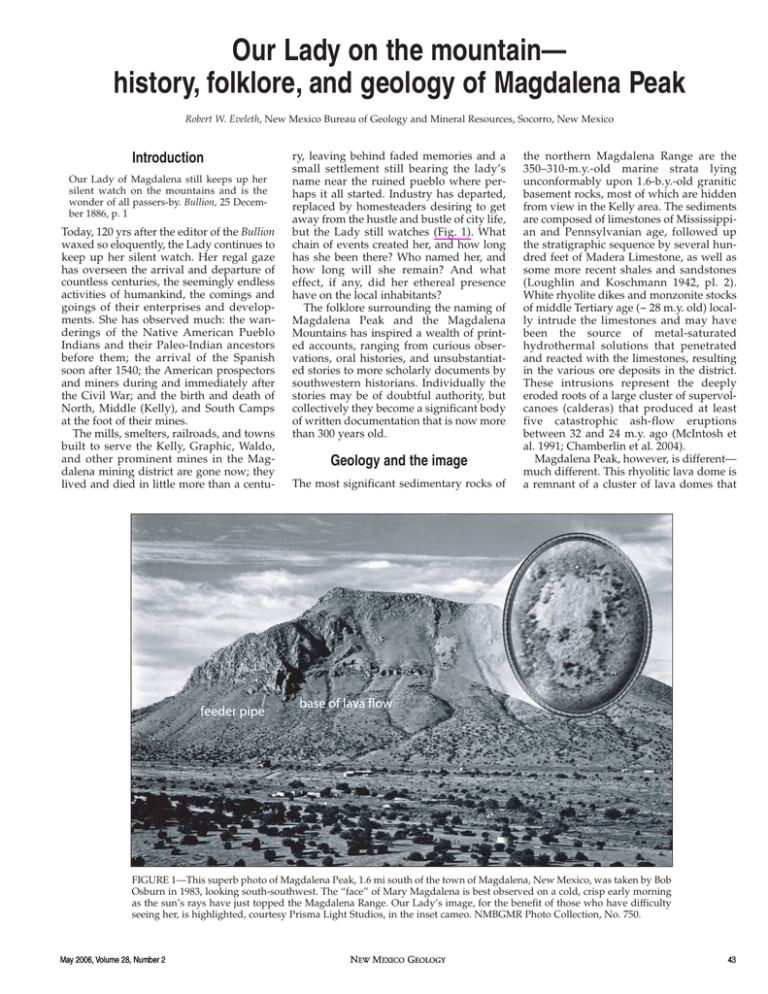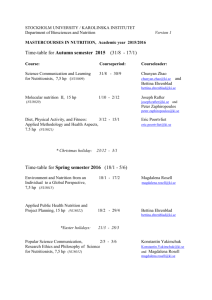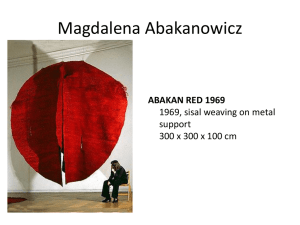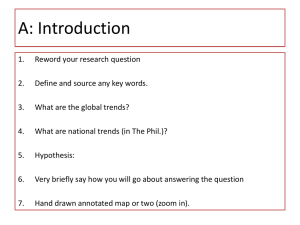Introduction
advertisement

Our Lady on the mountain— history, folklore, and geology of Magdalena Peak Robert W. Eveleth, New Mexico Bureau of Geology and Mineral Resources, Socorro, New Mexico Introduction Our Lady of Magdalena still keeps up her silent watch on the mountains and is the wonder of all passers-by. Bullion, 25 December 1886, p. 1 Today, 120 yrs after the editor of the Bullion waxed so eloquently, the Lady continues to keep up her silent watch. Her regal gaze has overseen the arrival and departure of countless centuries, the seemingly endless activities of humankind, the comings and goings of their enterprises and developments. She has observed much: the wanderings of the Native American Pueblo Indians and their Paleo-Indian ancestors before them; the arrival of the Spanish soon after 1540; the American prospectors and miners during and immediately after the Civil War; and the birth and death of North, Middle (Kelly), and South Camps at the foot of their mines. The mills, smelters, railroads, and towns built to serve the Kelly, Graphic, Waldo, and other prominent mines in the Magdalena mining district are gone now; they lived and died in little more than a centu- ry, leaving behind faded memories and a small settlement still bearing the lady’s name near the ruined pueblo where perhaps it all started. Industry has departed, replaced by homesteaders desiring to get away from the hustle and bustle of city life, but the Lady still watches (Fig. 1). What chain of events created her, and how long has she been there? Who named her, and how long will she remain? And what effect, if any, did her ethereal presence have on the local inhabitants? The folklore surrounding the naming of Magdalena Peak and the Magdalena Mountains has inspired a wealth of printed accounts, ranging from curious observations, oral histories, and unsubstantiated stories to more scholarly documents by southwestern historians. Individually the stories may be of doubtful authority, but collectively they become a significant body of written documentation that is now more than 300 years old. Geology and the image The most significant sedimentary rocks of the northern Magdalena Range are the 350–310-m.y.-old marine strata lying unconformably upon 1.6-b.y.-old granitic basement rocks, most of which are hidden from view in the Kelly area. The sediments are composed of limestones of Mississippian and Pennsylvanian age, followed up the stratigraphic sequence by several hundred feet of Madera Limestone, as well as some more recent shales and sandstones (Loughlin and Koschmann 1942, pl. 2). White rhyolite dikes and monzonite stocks of middle Tertiary age (~ 28 m.y. old) locally intrude the limestones and may have been the source of metal-saturated hydrothermal solutions that penetrated and reacted with the limestones, resulting in the various ore deposits in the district. These intrusions represent the deeply eroded roots of a large cluster of supervolcanoes (calderas) that produced at least five catastrophic ash-flow eruptions between 32 and 24 m.y. ago (McIntosh et al. 1991; Chamberlin et al. 2004). Magdalena Peak, however, is different— much different. This rhyolitic lava dome is a remnant of a cluster of lava domes that FIGURE 1—This superb photo of Magdalena Peak, 1.6 mi south of the town of Magdalena, New Mexico, was taken by Bob Osburn in 1983, looking south-southwest. The “face” of Mary Magdalena is best observed on a cold, crisp early morning as the sun’s rays have just topped the Magdalena Range. Our Lady’s image, for the benefit of those who have difficulty seeing her, is highlighted, courtesy Prisma Light Studios, in the inset cameo. NMBGMR Photo Collection, No. 750. May 2006, Volume 28, Number 2 NEW MEXICO GEOLOGY 43 FIGURE 2—First known photograph of “Mary Magdalena.” Image by E. A. Bass, Socorro, New Mexico, ca. 1885. Author’s collection, enlarged approximately 75%. erupted between 18 and 11 m.y. ago. Magdalena Peak formed 13.1 m.y. ago1 by an initially explosive eruption of ash followed by a slow effusion of pasty rhyolite lava. Just how violent? Identical “fingerprints” are almost as rare in nature as they are in human forensics. Only when geologists determined that indivitual ash beds in the Silver Creek and San Lorenzo Canyon areas some 15–25 mi to the northeast are analytically the same age as the lava domes at Magdalena did the relative violence of the formation of our Lady’s “palette” become apparent (R. Chamberlin, pers. comm. 2006; Newell 1997). Thirteen million years of uplift and erosion have carried away some three-fourths of the original volcano leaving the remnant visible today. The feeder pipe (plugged vent) is partially exposed near the south end of the peak, and the ledge-forming base of the lava flow can be seen toward the middle slope on the right (Eveleth and Osburn 1983, p. 44; Fig. 1). Erosion has also done something else: The rhyolite has broken up into angular blocks that have formed rugged talus slopes on the mountain’s steeper flanks. Because of a most curious happenstance of nature, the loose talus, most particularly in the center of the east-facing slope, is held in its current configuration by fortuitously positioned rock outcrops and vegetation. Fortuitous also is the slope of the mountain: sufficiently steep to have permitted some movement in the past and also sufficiently below the angle of repose to allow some stability in the present. This entire assemblage, sculpted solely by the hand of nature, has assumed a most startling and clear impression of a woman’s face in profile. It is this “petrifact”—the apparent image of a woman’s face—that has instilled superstitions within, and so completely captured the imaginations of, 44 human observers for time immemorial (Fig. 2). Legends and history The origins of the name “Magdalena” and the legends surrounding it are somewhat, but not entirely, engulfed by the mists of time. Leading up to the Spanish “entrada,” the first humans known to have visited the Magdalena area, based upon archaeological evidence, were the Native Americans. Paleo-Indians, such as the Folsom bison hunters, are known to have camped along La Jencia Creek ca. 12,000 yrs ago (R. Weber, pers. comm. 2004), and in more recent times the local Piros and possibly other Pueblos, Navajos, Mogollons, Apaches, and Comanches as well. One of these latter peoples, doubtless the Piros, built a notable pueblo near present-day Pueblo Spring (Ojo del Pueblo) 1.5 mi northwest of Magdalena, a pueblo that was in ruins and assumed to be ancient even when visited by Diego de Vargas in 1692 (Marshall and Walt 1984, p. 256). Moreover, recent discoveries coupled with scholarly archaeological research indicate that the Native Americans knew of and exploited the mineral deposits at Magdalena hundreds of years before the arrival of the Spanish. For example, keen observers in the Magdalena area have long noted worked lithic fragments of the sky-blue mineral smithsonite (zinc carbonate, ZnCO3), a mineral found locally in the Kelly area deposits, the only regional source. The fragments have been ground flat and many of them drilled, obviously for decorative purposes. One specimen is a beautifully wrought and complete smithsonite bead.2 More recently archaeological studies using “isotopic fingerprinting” (coupled plasma mass spectrometry) indicate the Zuni Pueblos obtained at least NEW MEXICO GEOLOGY some of their lead-copper glazes from the Magdalena mineral deposits (Huntley 2004).3 Magdalena was apparently too far off the beaten track for the Spanish to have accomplished much in the way of mineral exploration, and the territorial press is surprisingly silent in that regard. This is in direct contrast to uncounted references to alleged Spanish-era prospecting at other places such as Sierra Oscura, San Andres, Sierra Ladrones, etc. (To the early American prospectors the presence of an old Spanish working was an obvious indication of nearby mineral wealth.) Regardless, slight traces of Spanish-era prospecting could be found in the early days if one looked closely. One such indication was an old prospect pit some 300 yards northwest of the Ace of Spades mine in the Pueblo district (“Corona del Pueblo” in the 1860s) that was visible when American prospectors first arrived and was assumed to be Spanish in origin (Jones 1904, p. 123). Vivian V. Clark who grew up in the mining camp of Kelly in the 1880s repeated a story in vogue during his childhood to the effect that [what would later be known as] “the Graphic mine was discovered and worked by the Spaniards in about 1760 (Clark 1942).” Lead deposits in the Kelly area were so obvious that it is hard to imagine the Spanish not taking note of them (R. Weber, pers. comm. 2002). Physical evidence, however, is sparse indeed, and we are forced to conclude the remoteness of the deposits at that time permitted very little attention on the part of the otherwise very observant Spanish explorers. Nevertheless the “legend” of Magdalena Peak derives directly from them and their culture. Sometime after the year 1540 a small party of Spanish explorers separated themselves from the main body of the Spanish Conquistadores, proceeded up the Rio Grande valley, and ventured west. Indians harassed the group until, out of provisions, suffering from the heat of day and cold of night, and seeking refuge from the elements, they suddenly discovered and were quite startled to observe the image of a “beautiful face hewn by the caprice of nature on the mountain” (Jones 1904; 1Precise age based upon modern argon-argon dating technique (± 0.5% analytical error). 2 NMBGMR Collection. The local Piros were obviously aware of and were exploiting the sky-blue smithsonite locally abundant in the Kelly area. The presence of such material has for years been noted near the Magdalena pueblos, particularly the large ruin near Pueblo Spring but has only recently generated considerable excitement within the archaeological community. 3 Similar ongoing studies could indicate that the so-called “Salinas” Pueblos used both the Hansonburg and Magdalena lead ores for their glazes (H. Milford, pers. comm. 2002). May 2006, Volume 28, Number 2 W.P.A. files; Blackburn 1924; Magdalena Mountain Mail 1984; Fig. 3). The daring explorers retained memories of a similar legend in their culture dating back to the early days in Spain as per the following narrative in the W.P.A. files (“Magdalena”): According to a tradition still in vogue in Old Spain, St. Mary Magdalene, after Our Lord’s death, had followed the apostle St. James to Spain. Here she is said to have spent her last days in penance and prayer on a mountain. After her death the pious natives of the surrounding country claimed that the image of a beautiful woman’s face had suddenly appeared in the mountainside, hewn by unknown hands. So, in memory of Mary Magdalena, the Spanish mountain was called “La Sierra de Maria Magdalena.” Our group of Spanish explorers, recalling this legend, were so struck by the similarities of this apparition to the one in their native country that they immediately christened the mountain “La Sierra de Magdalena.” There was nothing unusual in this practice; in fact it seems the Spanish routinely saw faces and profiles in cliffs and rock formations wherever they went in the New World.4 The Apaches and other war-like Indians noticed them too and, being a superstitious lot, were said to avoid the Magdalena Peak area entirely or if nearby, to refrain from molesting travelers “whether white or red” (Twitchell 1917, p. 288–289) within sight of the Lady’s watchful gaze. This spot became a place of refuge and the savage Indian would forego his bloody deeds under the shadow of the holy mount. Those in danger would flee to this enchanted spot and thus become invulnerable from the onslaught of their pursuers (Jones 1904, p. 119). Only thus did our group of hardy Spanish explorers live to tell the tale, but history has thus far deprived us not only of their identities but of the location of their “La Sierra de Maria Magdalena” as well. Ninety years, in fact, have passed since Allen (1916, p. 26) reported, “There is no data obtainable as to when or by whom of the early Spanish explorers ‘Our Lady Magdalena’ was discovered or named…” and the situation remains unchanged today.5 The Indians, without question, were aware of her presence long before the Spaniards and certainly possessed their own body of folklore. So superstitious were the Native Americans that ”…no crime or murder could be or ever would be committed within view of the profile…” (Allen 1916, p. 26). The few early American prospectors who took the trouble to acquaint themselves with the local Indians and their customs spoke—only too briefly—about these beliefs. One writer reported that there were “some curious Indian traditions about these mountains [Magdalenas and the San Mateos] that I may give you in your columns at some future date (“RHS” in Santa Fe Daily New May 2006, Volume 28, Number 2 FIGURE 3—Exceptionally sharp real photo post card view with the face of “Mary Magdalena” highlighted like a fine cameo. Photo by Frasher’s Fotos, Pomona, California, ca. 1950. Author’s collection. Mexican, 1 June 1881, p 2).”6 Alas no follow-up article was found, and whatever folklore the writer possessed remains lost to us. Of greatest importance, though, is the knowledge that the Indians did have their superstitions, and it follows that the Lady had been around long enough for them to form a well-established body of folklore. “No crime or murder could be...would be committed,” suggests some mighty powerful “medicine” at work here.7 Very likely they had their own name for the image, but it too is lost to history. Many of the early explorers and trailblazers did make an effort to determine Indian names, but often found them to be hopelessly indecipherable. For example, John Lambert, one of the topographers for the great 1853–1854 railroad surveys from the Mississippi River to the Pacific Ocean stated that no effort was spared in this regard but the names recovered were often just “the beginning…of a hopelessly unpronounceable...Indian name, which extends to ten or twelve guttural sounds (Lambert 1854, p. 160).” The author’s efforts to unearth a local Indian name for the Lady on the Mountain have thus far been unsuccessful. Regardless, the current name and perhaps the legend of Magdalena Peak have been handed down for more than 300 yrs. Of this we are absolutely certain because the names “Sierra Magdalena” and “Sierra de la Magdalena” are well established within hundreds of years of both written and cartographic history. The former, for example, appears on a U.S. War Department Bureau of Topographic Engineer’s map of 1859 (Fig. 4), and the latter can be traced at least as far back as Bernardo de Miera y Pacheco’s map of ca. 1770 (Fig. 5). And finally, Bandelier (1892, footnote 1, p. 250) refers to the murder of the alcalde NEW MEXICO GEOLOGY mayor at the hands of the Indians “en la Sierra de la Magdalena” before 1669.8 It 4Another is the profile-like feature on the northern end of the Sierra Fra Cristobal “said to be named after Father Commissary Fray Cristobal of the Onate expedition because of the resemblance of his face to the profile (Marshall and Walt 1984, p. 240).” A recent chronicler said of the landmark that it “is an Irish and not a Spanish profile, and is smiling. So brother Cristobal must have been a jolly friar, as St. Francis wished his disciples to be (Hallenbeck 1950, p. 351).” The Socorro County mountain, it should be noted (Julyan 1996, p. 217), is not the only Magdalena Peak in New Mexico: the second (also bearing a rock formation allegedly resembling the profile of Mary Magdalene) is approximately 12 mi south of Hatch in Doña Ana County in SE1⁄4 sec. 8 T21S R3W, on the east end of the Sierra de las Uvas and prominently shown on the USGS 1943 edition of Corralitos Ranch 15-min quadrangle. The feature appears as “Sierra Magdalen” [sic] on Lt. George M. Wheeler’s preliminary map of 1880 (q. v.). 5 There is hope that with wider access to the ancient Spanish archives in Spain and elsewhere, serious scholars will ultimately unearth a long-lost entry in a forgotten Spanish explorer’s journal or diary. 6 Robert H. Stapleton was a pioneer of the Magdalena mining district and a regular contributor to the territorial press. Conceivably, since this item was copied by the Daily New Mexican from the Socorro Sun, “RHS” could easily have been Stapleton writing under a nomde-plume. 7According to Webster’s Unabridged dictionary, the word “medicine” is used by the North American Indians to describe “any of various objects supposed to give control over natural or magical forces or to act as a protective or healing charm.” 8 Southwestern scholars think that the alcalde mayor of the Piros’ district was Luis Lopez himself who was not heard from or seen after about 1667—see, for example, Wilson 1985, p. 117. 45 FIGURE 4—Portion of the U.S. War Department Bureau of Topographic Engineer’s map of 1859, partly revised to 1867, depicting the Sierra Magdalena west of Socorro. The cartographer obviously experienced difficulty with Spanish names, and misspellings are common. Salient features are Pueblo (“Puebla”) Spring where American mineral exploration is said to 46 have begun in 1863; Ojo Arieta ( “Ariste [sic],” i.e., “Hill Spring,” near South Camp). Socorro County Mining Records, Book 6, p. 419. Courtesy Map and Geographic Information Center, Centennial Science and Engineering Library, University Libraries, University of New Mexico. NEW MEXICO GEOLOGY May 2006, Volume 28, Number 2 FIGURE 5—Bernardo de Miera y Pacheco’s map of the Rio del Norte from El Paso to San Pascual (north of Socorro), ca. 1770, is the oldest cartographic document known to depict the “Sierra de la Magdalena” (near top May 2006, Volume 28, Number 2 margin just west of the Rio Grande). Courtesy Map and Geographic Information Center, Centennial Science and Engineering Library, University Libraries, University of New Mexico. NEW MEXICO GEOLOGY 47 FIGURE 6—1954 Spanish postage stamp commemorating Mary Magdalena. Earlier issues, such as the 1931 Montserrat series, depicted the Rocks of Santa Magdalena but did not name them. Author’s collection. should be noted that the local Piros of Senecu, and not the Apaches as originally thought, committed and were executed for this murder (J. Wilson, pers. comm. 2002; Wilson 1985), and it is therefore likely the murder took place in the eastern foothills of the Magdalenas well out of sight of Mary Magdalene. Our Lady’s reputation thus appears to have survived unsullied. The above exercise serves to demonstrate the name “La Sierra de Magdalena” was established sometime between 1540 and 1669, long before the first Englishman’s boot is known to have trod southwestern soil, and essentially proves that a Spaniard named it and did so because of the remarkable cameo-like image on its flanks, which, in turn, reminded him/them of the “La Sierra de Maria Magdalena” in their native country.9 The alleged Spanish connection: fact or fiction? At what point does a legend emerge from the shadows of a myth and into the light of history? Is the “legend” truly based upon historical precedents or is it nothing more than the brainchild of a few over-imaginative, home-sick Spanish explorers? The “Legend of Magdalena Peak” would gain much credibility if there were a “sister” mountain in Spain bearing salient features matching the above story. The fact that no known previous chronicler has undertaken to locate such a mountain strongly suggests the whole story is, well, a story. But dogged persistence occasionally pays off. Are clues to be found within the W.P.A. narrative? Consider: “after her death the pious natives of the surrounding country claimed that the image of a beautiful woman’s face had suddenly appeared in the mountainside, hewn by unknown hands.” “In the mountainside?” This suggests that the image, if it exists, might be somewhat different than the profile in the Magdalena talus—more of a silhouette or an outcrop on a rock cliff (like the oncefamous Old Man of the Mountains in New Hampshire). 48 FIGURE 7—Map of area around the historic Montserrat monastery. The “Sierra Magdalena” is located approximately 1 km west-southwest of the monastery and approximately 250 m north of the Sierra San Juan, the terminus of the funicular (inclined railway). Vintage map, ca. 1913; author’s collection; published Karl Baedeker. The search is made somewhat difficult by the fact that, second only to Mary and Jesus, Mary Magdalene is perhaps Spain’s most popular religious icon. She has been commemorated on Spanish postage stamps (Fig. 6), and her name has been liberally applied to various places around the country. A few such examples are the Magdalena River near Granada; the Magdalena neighborhood of Pamplona, in north-central Spain; the Peninsula de la Magdalena at Santander on the northern coast; and the old Magdalena Convent at Barcelona on the east coast and just barely 100 km south of France. NEW MEXICO GEOLOGY 9Perplexing is the apparent absence of accounts, apocryphal or otherwise, in known and/or extant copies of the Socorro and other territorial New Mexico newspapers. The earliest printed reference regarding the “legend” noted by the author to date is in Jones (1904, p. 119), but the legend and story were obviously committed to folklore long before Jones’ arrival upon the scene. Uncle Jimmie McKenna (q. v.), in an account allegedly dating from the 1880s but not published until 1936, quotes (p. 61) his partner Jason Baxter: “Did you boys know there has never been a murder done in that mountain? Even an Apache will not kill an enemy if he can get within the shadow of the woman’s face…” May 2006, Volume 28, Number 2 The legend further states that Mary Magdalene followed the apostle St. James to Spain. Is it thus possible her mountain might be located in the vicinity of Santiago de Compostela, the alleged final resting place of St. James the Apostle in Galicia province on the northwest coast? Here the mystery only deepens because there is a mountain known as the “Monte de la Magdalena” approximately 30 km east of Santiago de Compostela. Neither this peak nor any of the other places mentioned above are known to possess a rock edifice, cliff, or a natural “sculpture” resembling a woman’s face. End of story? Not quite! Let us revisit Barcelona, or more specifically, nearby Montserrat in the province of Catalonia approximately 38 km to the northwest of the eastern Spanish metropolis. The countryside around Montserrat is breathtaking to say the least, and the place has experienced miracles sufficient to gladden the hearts of the Benedictine brotherhood’s most devout dating back to at least A.D. 880. Could the latter be the “pious natives” referenced in the narrative? The monastery at Montserrat, surrounded by the Mountain of 100 Peaks, is a major attraction. And less than 1 km west-southwest of the monastery there is a feature named “Sierra Magdalena” (Fig. 7). The pinnacles are plainly visible from both the monastery and the upper station of the San Juan Funicular (Fig. 8), but is this truly the sister of our Sierra Magdalena? A photograph of this mountain, taken from the proper angle, reveals what is very possibly Magdalena, New Mexico’s namesake at last! Locally this group of pinnacles is called the “Peñas de Santa Magdalena” (or the more French/Basque influenced “Les Roques de Santa Magdalena”) both meaning “Rocks of Santa Magdalena” (Fig. 9). Note especially the center of the five spires. The upper portion, with but little imagination, bears an uncanny resemblance to a woman’s face. She appears to be lying on a pillow (as in death, perhaps?) with her forehead at the top, at least one eye and nose below, and mouth at the bottom. We can easily imagine the pious natives’ surprise when they first noted “that the image of a beautiful woman’s face had suddenly appeared in the mountainside.” According to one local source: “These fantastic shapes of the rocks and the Montserrat needles have invited the inhabitants of the region, from ancient times, to give [them] meaningful or appropriate names…and they have invented marvelous legends about [them]” (Escudo de Oro 1996, pp. 28, 31)—the Rocks of Saint Magdalena among them. 10 Are the marvelous legends based, at least in part, upon historical precedents? Does it really matter? The fact is no one knows, but this is immaterial because the Spanish explorers obviously believed their own legend well enough to pass the place name along May 2006, Volume 28, Number 2 FIGURE 8—Vintage post card view, ca. 1910, of the upper station of the San Juan Funicular showing the “Rocks of Santa Magdalena” above the station and the well-worn pilgrimage trail between the two. FIGURE 9—Vintage post card view, ca. 1910, of the "Rocks of Santa Magdalena." The reader is directed to the upper portion of the center pinnacle where, with but little imagination, one can visualize the face of St. Mary Magdalene. Given the fact that no life portrait of Mary Magdalene is known to exist, is it mere coincidence that the postage stamp image bears remarkable similarities to the "sculpture" on the mount? Both post card views are in the author's collection (Zerkowitz 1910). to us. Keep in mind the author is not claiming that the Rocks of Santa Magdalena at Montserrat are without question the feature for which our mountain was named— that will have to await future confirmation. But the Santa Magdalena pinnacles, subsequent to a 20-yr search, are the best (in fact the only) candidate to appear thus far. 10This suggests that at least one of our intrepid Spanish explorers hailed from the Barcelona– NEW MEXICO GEOLOGY Montserrat region. In fact, an individual from the Montserrat region is said to have accompanied Columbus as the pontifical representative (Escudo de Oro 1996, p. 10) and another to have embarked upon expeditions to the Americas in the 1500s–1600s (L. Zeising, pers. comm. 2006). 11Other claimants appearing on the first locations were H. M. Enos, W. F. Strachan, H. Carpenter, Lorenzo Montoya, Major T. Brotherton, J. Springer, and J. Parsons (Socorro County Mining Records, Book U, p. 115). The miners originally called their new discovery the “Spring Hill mining district” because of the (then) permanent “Arieta” or “Hill” spring nearby. 49 Native Americans and the Magdalena mining district The district receives its name from the gigantic face of a woman roughly hewn out of the mountain side by the hand of nature …E. A. Klauser 1888 (Santa Fe Daily New Mexican, 7 April 1888, p. 4: Originally published in the Kansas City Record). Although not known as such until the mid1870s, the Magdalena mining district was born in 1866–1867 when American prospectors “Col.” John Samuel Hutchason, popularly called “Old Hutch,” Berardo Fraire, and doubtless several others11 first rode into the area on a prospecting campaign. We can only surmise their thoughts at their first encounter with Mary Magdalene because they left no known written account. It is no surprise that Hutch and Fraire named one of their first three mining locations the “Magdalena Lode” (Socorro County Mining Records, Book U, p. 115). Miraculously—dare we say predictably—Hutch and Fraire experienced no difficulties with Indians. In fact, from the time of discovery until the end of the so-called Indian wars, the author has unearthed no record of Indian attacks in the Magdalena or the Kelly area mining camps. The newspapers are loaded with accounts of Indian depredations, plunder, and murder throughout the territory, even just outside of Socorro (Bullion, 1 October 1883, p. 3; 1 June 1884, p. 7) but not in Kelly, Pueblo Springs, or Magdalena. Pilfering and “borrowing” of livestock certainly, but no scalping and no Indians on the warpath. Nevertheless the pioneer prospectors took no chances and pointedly avoided the use of camp fires and even shunned the otherwise indispensable but way too vocal “desert canary”—both of which could have revealed their location to the ever-observant Indians (Bippus 1884).12 A typical pilfering raid was reported as follows: “a party of Indians, supposed to be Navajos, made a raid on the mining camps in the Magdalena mountains last week, and ran off a lot of stock, including three horses belonging to Mr. Hutchason…” This was certainly not an unusual occurrence as a similar raid was made “last year about this time…” (Santa Fe Daily New Mexican, 26 June 1873, p. 1). Hutch later wrote to the same paper: “It has become [the Navajos] habit heretofore to lay ‘round a few days to disarm us of suspicion, then steal all our stock and make off to parts unknown. I fear if our miners should trap them stealing stock that some of them would get hurt…” (Santa Fe Daily New Mexican, 14 April 1874, p. 1). It should be noted that the Navajos referred to herein were not the Alamo band near Magdalena but a nomadic group located well to the north “near Cebolleta.” The Bullion in fact had nothing but praise for the local Navajos: “The occupation of [these] people consists in hunting mainly, though they are 50 now devoting themselves…to agriculture and the raising of cattle and horses. The women are principally engaged in the manufacture of the celebrated Navajoe [sic] blanket which is woven so tightly that water will not penetrate…they are sober and industrious and entirely self-supporting” (28 April 1885, p. 6). The same could not be said for Victorio, Nana, Geronimo, Loco, and others who regularly wrought havoc and terror in the nearby mining camps and settlements of Mogollon, Cooney, and Alma and whose murderous deeds were well recorded in the annals of New Mexico’s territorial history. All engaged in forays well up into the northern Black Range and San Augustin Plains area (Allen 1916, p. 42). When Geronimo made his last great outbreak in mid-May 1885 (Bullion, 26 May 1885, p. 5) and vowed to kill every white man in New Mexico (as had Victorio before him) the miners and townspeople in Magdalena, Kelly, and Pueblo fortified themselves as best they could and prepared for the worst. E. Crosson of Magdalena tried to instill some calm by declaring that there had “not been a hostile Indian within a hundred miles of Magdalena this year,” but the locals decided it was far better to be safe than sorry. Special fortifications were established at the mining camps in preparation for the impending danger. “The Kelly mine received a large amount of fixed ammunition last week, and if any Indians had shown themselves, the miners would have made short work of them” (Bullion, 2 June 1885, p. 5). Hutch’s brother, T. S. Hutchason at Pueblo Springs, likewise reported, “the boys [here] will hold the fort against the Indians if all hell turns loose against them,” then dryly noted that the boys could use “a consignment of cartridges (Bullion, 2 June 1885, p. 6).13 Vivian V. Clark, who grew up in the young and booming mining camp of Kelly (a.k.a. “Middle Camp”) was a teenager at the time of Geronimo’s last campaign. Clark’s father, C. C., ran the first-class Clark House hotel. His mother was the first schoolmarm of the Kelly Public School, and he would later attend the opening classes at the fledgling New Mexico School of Mines in 1893. Clark, in his first-hand account of that event (1937, p. 2), tells us that many of the townspeople took no chances: when Geronimo went out on the warpath… hundreds of settlers camped under the face of Mary Magdalena, just below Kelly, for protection. It was believed by them that the Indians worshipped that face and that they had never scalped a pale face within some 20 miles of Mary Magdalena. (See also Anon. 1902, p. 9). Their belief in the protective powers of Mary Magdalene—or at least their belief that the Indians believed—was so deeply ingrained that they preferred camping at the foot of the mountain to the relative NEW MEXICO GEOLOGY security of their homes and protection of their well-armed neighbors.14 Crosson was correct in his surmise: Regardless of the underlying reasons, whether chance, fate, or superstition, Geronimo and his band avoided the area once again and instead turned south to Mexico where, in Skeleton Canyon during September 1886, they were finally induced by General Miles to surrender. “Throughout the Indian wars and depredations covering a century of time in the history of New Mexico, the Apaches, Navajos and other tribes avoided the [Magdalena] mountain, and this was especially true during the raids of Victorio and Geronimo in the present generation. These chieftains never molested the early settlers and prospectors” (Allen 1916, p. 26). Without doubt something quite extraordinary was going on here. The image of Mary Magdalena came to assume the role of official “mascot” of the Magdalena district, always there casting her benevolent countenance over the mines and miners. She entered the inhabitants’ oral traditions, and the townspeople invoked her name in casual conversation. Passers-by often paused on their journey to or from Kelly to have their photographs taken with Mary Magdalene looking over their shoulders. When Asa B. Fitch, manager and lessee of the famed Graphic mine for the decade beginning 1893, selected a spot to build the family residence, the company “purchased the K. Foley tract of 160 acres…” and the Fitch hacienda was built “…at the foot of the Magdalena head…” (Chieftain 10 April 1896, p. 1).” Based upon the number of articles to appear in the local and regional press over the past decade or two, the fascination continues unabated. 12 “Desert canary” was the term universally applied by the miners to their pack burros, the latter of which unabashedly announced their presence regardless of time or place. 13 This clip identifies T. S. as Hutch’s cousin, whereas he is clearly identified elsewhere as his older brother. See, for example, his obituary notice in the Albuquerque Daily Citizen, 6 September 1893, p. 4. 14 Why did the Piros select the Magdalena site for their Pueblo? Certainly there were many other superb localities for them to have settled. Water Canyon, for example, offered an abundance of water, protection from the elements, and perhaps even high cliffs and natural caves for personal protection. Could they too have been more comfortable under the watchful gaze of Lady Magdalena? 15 Greer Price, the bureau’s eloquent and allobserving geological editor, upon first viewing the Lady’s image in the Osburn photograph, exclaimed, “She looks just like Marie Antoinette!” May 2006, Volume 28, Number 2 Down through the ages: that old outlaw time A lady called our attention the other day to the fact that the face on the Magdalena mountain bears a close resemblance to that of the unfortunate Marie Antoinette (Bullion, 1 August 1885, p. 3).15 There is nothing that delights me more than driving into Magdalena and contemplating this image all the while, for one sees the face long before he does the town. It seems to beckon and say, “Welcome, welcome; come again.” (Carey Enloe, Chieftain, 28 December 1929, p. 4). Many observers see Mary Magdalena differently. Some claim they don’t see her at all, or what they do see bears little resemblance to the generally accepted profile (Magdalena Mountain Mail 1983). There are those who insist that the image has changed so much over the years that she is no longer recognizable (Ross 1983). The author regrets he must respectfully disagree with the above: To his eye, the image stands out clearly in profile like the lady’s face on a fine cameo ring as so vividly portrayed in Figure 1. Whether she looks the same to us today as she did to the early Indians and Spanish we cannot say, but based upon actual photographs dating from the late 19th century we can state that she has changed but little since at least ca. 1885. Intuitively, however, we know the “old outlaw time” has and will continue to subtly change her appearance. Close scrutiny in fact suggests that the locks of her hair have grown somewhat or at least are more pronounced, perhaps due to the dislodging of a single large boulder: Compare for example, her hair in the Osburn view (Fig. 1) to that in the post card view (Fig. 3). Weather conditions and the time of day, it should be noted, have a profound effect on the appearance: The best viewing time is on a cold crisp day when the polarized light of the early morning sun is just rising over the Magdalenas. So sharp and startling is the view at that time the image has been likened by various observers to the face of Mercury on an old U.S. silver dime, or to the well-known and long-used bust of Queen Elizabeth II on stamps and coins of the British Commonwealth, or even, as previously noted, to a famous portrait of Marie Antoinette! It has often been said that it is improper to ask a lady her age, but in the case of the face of Mary Magdalene the question is entirely appropriate. This lady’s age is of great geologic interest for her image has had a profound effect upon the folklore, beliefs, and behavior of the local inhabitants for hundreds—if not thousands—of years. Most would conclude that such an ephemeral work of nature, subject to the powerful forces of freeze and thaw, sun and wind, and the occasional torrential May 2006, Volume 28, Number 2 downpour, must be a very short lived phenomenon. Short lived in terms of geologic time certainly but not in terms of human history. We have demonstrated, for example, that Lady Magdalena has been around at least since the arrival of the early Spanish and very probably long before. Exactly how long we cannot say with any certainty, but we should note that the vegetation responsible, in part, for maintaining the Lady’s position on the mountainside is of late Holocene age and thus evolved since the last 1,000 yrs (R. Chamberlin, pers. comm. 2004). The Lady’s age, therefore, is more properly reckoned in terms of hundreds of years. Regardless of her age or whether the Lady conjures up feelings of fear in times of misdeed, succor in times of danger, or simply beckons one to return another day, she will doubtless, barring some unforeseen geological mishap or human malevolence, remain with us long into the future. Acknowledgments The author is indebted to the following for their valuable counsel and input over the years: Dr. Robert Weber for his long-term observations relative to the Piros and Paleo-Indians in the San Augustin Plains area; Dr. Richard Chamberlin for his observations and meticulous guidance on the ages of geologic features; Dr. John Wilson for sleuthing out deeply buried historical facts; Mark Mansell and Richard A. Bell for their keen observations and data sharing; Rebecca Titus Taylor, Prisma Light Studios, for her artistic touches on Figure 1; Lucinda Zeising who graciously researched the legends of Montserrat and the Rocks of Santa Magdalena while conducting scholarly studies in Barcelona, Spain; and Homer Milford for providing insight into the various Spanish expeditions and critiquing the manuscript. Special thanks to Gary Stendel for carefully preserving and sharing his copy of the ultra-rare magazine “Magdalena, Queen of the Mountains” and Bob Julyan for his critical review. References Allen, R. S., ed., 1916, Magdalena: The Mogollon mines, 7th ann. ed., Silver City, New Mexico, 48 pp. Anon., 1902, Magdalena: Miner & Manufacturer, El Paso, Texas, October 1902, p. 9. Anon. stated: “…high on a mountain side is almost a perfect face of a woman. This was called Lady Magdalena and worshipped by the Indians…” Baedeker, K., 1913, Monasterio de Montserrat, vintage map of area surrounding the historic monastery at Montserrat, Spain: Handbook for travelers, 4th ed., Leipzig, Germany, 594 pp. Bandelier, A. F., 1892, Final report of investigations among the Indians of the southwestern United States, Part II: Papers of the Archaeological Institute of America, American Series, IV, John Wilson & Son, Cambridge, Massachusetts, 591 pp. Bippus, J. J., 1884, Then and now: Bullion, 1 August NEW MEXICO GEOLOGY 1884, p. 5. A contemporary look at the ‘good old days’ in Socorro and the Magdalenas, written by one of the pioneers speaking (somewhat humorously) at length about the pioneer prospectors’ efforts to avoid Indians. Blackburn, L., ed., 1924, Magdalena, queen of the mountains: Single-issue tourist-oriented magazine, Magdalena, New Mexico, July 1924, 20 pp. Bullion, territorial newspaper originally published in Socorro, New Mexico. Chamberlin, R. M., McIntosh, W. C., and Eggleston, T. L., 2004, 40Ar/39Ar geochronology and eruptive history of the eastern sector of the Oligocene Socorro caldera, central Rio Grande rift, New Mexico; in Cather, S. M., McIntosh, W. C., and Kelly, S. A. (eds.), Tectonics, geochronology, and volcanism in the Southern Rocky Mountains and Rio Grande rift: New Mexico Bureau of Geology and Mineral Resources, Bulletin 160, pp. 251–279. Chieftain, a.k.a. El Defensor Chieftain, newspaper published in Socorro, New Mexico. Clark, V. V., 1937, Mining engineering is not all engineering: New Mexico School of Mines, Gold Pan, 8 November 1937, p. 2. Clark, V. V., 1942, Half a century of progress in mining and metallurgy in the United States: Unpublished manuscript drawn from a series of lectures delivered before the Mining Group at Santo Tomas, Manila, by Professor Clark, Head and Professor, Department of Mining Engineering, University of the Philippines, Manila, 140 pp.; author’s collection. Enloe, C., 1929, Chieftain, 28 December 1929, p. 4. Escudo de Oro, 1996, All Montserrat, by the editors, Escudo de Oro, S. A., 11th ed., 96 pp. Espinosa, J. M., 1940, First expedition of Vargas into New Mexico, 1692: University of New Mexico Press, Albuquerque, 319 pp. Eveleth, R. W., and Osburn, G. R., 1983, Gallery of Geology—Magdalena Peak: New Mexico Geology, v. 5, no. 3, p. 44. Hallenbeck, C., 1950, Land of the conquistadores: Claxton Printers, Caldwell, Idaho, 375 pp. Huntley, D., 2004, Interaction, boundaries and identities—a multiscalar approach to the organizational scale of Pueblo IV and Zuni society: Unpublished Ph.D. dissertation, Arizona State University, 275 pp. Jones, F. A., 1904, New Mexico mines and minerals: World’s Fair Edition, Santa Fe, 1904, 349 pp. + biographical appendix. Julyan, R., 1996, The place names of New Mexico: University of New Mexico Press, Albuquerque, 385 pp. Lambert, J. 1854, Report of the topography of the route from the Mississippi River to the Columbia, June 1, 1854: Reports of explorations and surveys…etc., Senate Ex. Doc. No 78, 33d Congress, 2d Session, vol. 1, Washington, D.C., Beverley Tucker, printer, 1855. Loughlin, G. F., and Koschmann, A. H., 1942, Geology and ore deposits of the Magdalena mining district, New Mexico: U.S. Geological Survey, Professional Paper 200, 168 pp. Magdalena Mountain Mail, 1983, The face on the mountain at Magdalena, N.M.: Magdalena Mountain Mail, 2 July 1983, p. 8. Magdalena Mountain Mail, 1984, Centennial Magdalena: Special insert to accompany the 31 March 1984 issue, n. p. Marshall, M. P., and Walt, H. J., 1984, Rio Abajo— prehistory and history of a Rio Grande province: New Mexico Historic Preservation Division, Santa Fe, New Mexico, 346 pp. McIntosh, W. C., Kedzie, L. L., and Sutter, J. F., 1991, Paleomagnetism and 40Ar/39Ar ages of ignimbrites, Mogollon–Datil volcanic field, southwestern New Mexico: New Mexico Bureau of Mines and Mineral Resources, Bulletin 135, 79 pp. References continued on page 53. 51 Contamination migration by Tara J. Elkins Grants High School, Grants Winner, Senior Division Hype rages from all sides of the debate concerning contamination and the Homestake Milan uranium mill/tailings ponds, not just in reference to the actual contamination levels, where and how fast the contamination is moving, but in who is to blame, what is happening, and what should be happening to remediate the issue. Every family that lives or raises livestock in that area has a different fear, a different complaint, and a different statistic of the “polluted” water just a few hundred feet below them, but only a small few have a fact-based, strong understanding of the issue. The purpose of this investigation is to determine if there is an apparent trend in the migration of contaminants in the alluvial aquifer southwest of Homestake’s Milan tailings pile. Because of the gradient of the base of the alluvium, it is speculated that if contaminants in the aquifer are flowing, then they are flowing in a general southwest direction. To accomplish this, data of various major and minor constituents at 16 wells (each in the alluvial aquifer southwest of the tailings pile) over a 9 year period were collected from Homestake Mining Company records. The concentrations of uranium, selenium, total dissolved solids (TDS), and sulfate were analyzed, and their average yearly change in concentration was calculated. Once the average amount of change at each site was established, the results were plotted on maps of the site, which were then observed in search of a general trend in contamination flow. To better understand Homestake’s data sources, water samples were collected from four of the analyzed plots. Following the state’s and Homestake’s procedures, these samples were filtered, preserved, and tested for concentrations of the four constituents at hand. After all of the data were analyzed and plotted, small correlations hinting toward a southwesterly routed contamination flow, but no overall trend in migration of uranium, selenium, TDS, or sulfate, were observed. Because it is possible that plotting more data points and further research of the idea could possibly present a more apparent trend, this investigation will remain inconclusive. It’s believed that the data observed at the present time are not sufficient to determine the authenticity of the hypothesis. Photographs by Maureen Wilks. Continued from page 51. McKenna, J. A., 1936, Black Range tales—chronicling sixty years of life and adventure in the Southwest: Wilson-Erickson, New York, 300 pp. Newell, H, 1997, 40Ar/39Ar Geochronology of Miocene silicic lavas of the Socorro–Magdalena area, New Mexico, USA: Unpublished M.S. thesis, New Mexico Institute of Mining and Technology, Socorro, 190 pp. Ross, D., 1983, Magdalena—years of weathering take toll on Lady of Magdalena’s face: Santa Fe New Mexican, 24 June 1983. Santa Fe Daily New Mexican, territorial newspaper May 2006, Volume 28, Number 2 published in Santa Fe, New Mexico. Socorro County Mining Records books, Socorro County Courthouse, Socorro, New Mexico. Twitchell, R. E., 1917, The leading facts of New Mexican history, vol. IV: The Torch Press, Cedar Rapids, Iowa, 567 pp. Wheeler, Lt. G. M., 1880, Outline map of part of southwestern New Mexico, provisional map for use in advance of final publication, engraved by Louis Nell, Delaware, December 1880; NMBGMR archives, copy courtesy William T. Worthington. NEW MEXICO GEOLOGY Wilson, J. W., 1985, Before the pueblo revolt—population trends, Apache relations and pueblo abandonments in seventeenth century New Mexico; in Fox, N. L. (ed.), Prehistory and history in the Southwest: Archaeological Society of New Mexico, Santa Fe, Vol. 11, pp. 113–120. W.P.A. (Works Progress Administration) files, Magdalena: New Mexico State Records Center and Archives, Santa Fe, New Mexico, n.d., n. p. Zerkowitz, A., ca. 1910, Rocks of Santa Magdalena, Montserrat: Adolfo Zerkowitz, Barcelona, Spain, photographer and publisher. 53







